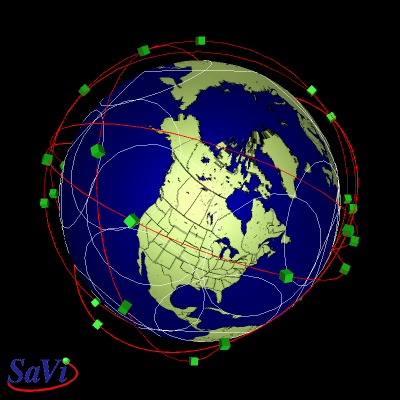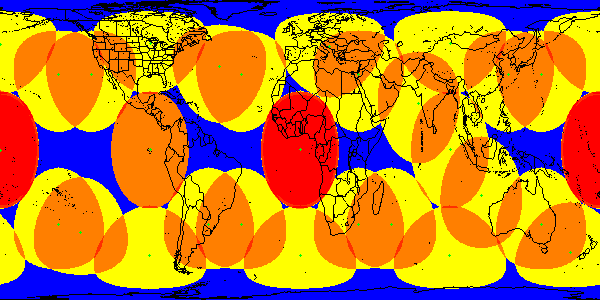
Full active Orbcomm constellation as modelled in SaVi
The official Orbcomm website
will tell you about this 'little LEO'
for data messaging that is already operational. Low bandwidth, no phones. See also
Korea Orbcomm.
Orbcomm filed for US Chapter 11 bankruptcy protection on 15 September 2000.
Since then,
an auction took place, establishing a new owner:
Advanced Communications Technologies. However,
they weren't able to reach agreement with Orbital Sciences over FCC licenses.
Orbital has since put together its own consortium, and taken control of Orbcomm.
Gary Dorsey's book Silicon Sky describes life inside Orbital Sciences from 1992 to 1995 as Orbcomm
was developed. I haven't read it yet, but BusinessWeek carried excerpts - on development of low-cost space services, on power gains from going to GEO and LEO (although atmospheric loss stays the same) and on the failed Orbcomm-X launch. Another short excerpt via Context Magazine. Browse for a book
Launches
If you want to track the satellites using the two-line element set format, here's a recent
NORAD two-line
element set for Orbcomm.
There's a regularly-updated downloadable TLE set
from NORAD via NASA's OIG - log
into their archive to get historical information. Orbitessera may also be useful.
Fourth Pegasus launch
A set of seven satellites was launched via Pegasus on 4 Deecember 1999. This is one less than was expected by my simulations of the ideal constellation shown on this page, and the launch was into an inclined orbit instead of the expected equatorial orbit. I've since had to revise my SaVi simulation script...
Third Pegasus launch
A third set of eight satellites was launched via Pegasus on 23 September 1998.
Second Pegasus launch
A second set of eight satellites was launched via Pegasus on Sunday 2 August 1998.
Secondary payload launch
Two more satellites were launched as secondary payload on a US Navy
GEOSAT follow-on launch. Launch coverage is
on the Florida
Today summary of the week.
Since then, two more Pegasus launches were announced and the FCC authorised another twelve satellites.
First Pegasus launch
Two satellites were already up for testing when an
aircraft-mounted
Pegasus rocket put an orbital plane of eight satellites into orbit on 23 December 1997. Images,
sounds and movies of that launch are available from the Florida Today summary of the week.
Seven satellites
began testing immediately, while the eighth satellite began communication later.
A quick summary of the Pegasus launch history is available.
General information
NASA
summary as described by Mike's Spacecraft Library,
with early orbital information on the satellites and orbital planes.
Quake Wireless manufactures Orbcomm
terminals for various applications.
Description of Orbcomm from the Small Satellites Home Page.
Remote monitoring terminals from Satellite Smart Solutions in Israel.
Quake Global produces modems for use with Orbcomme.
Orbcomm
monitors rare fish.
(Wired,
September 1996)
Magellan's latest GPS/Orbcomm handheld (Wired News, 25 August 1998)
Official pictures
courtesy of Orbital Sciences.
You can also
simulate Orbcomm with
SaVi

Orbcomm's idealised satellite footprints at a moment in time, generated by SaVi
The footprints move over the earth, some at different rates due to different orbital heights.
cylindrical projection
Lloyd Wood
(L.Wood@society.surrey.ac.uk)
this page last updated 16 May 2006



